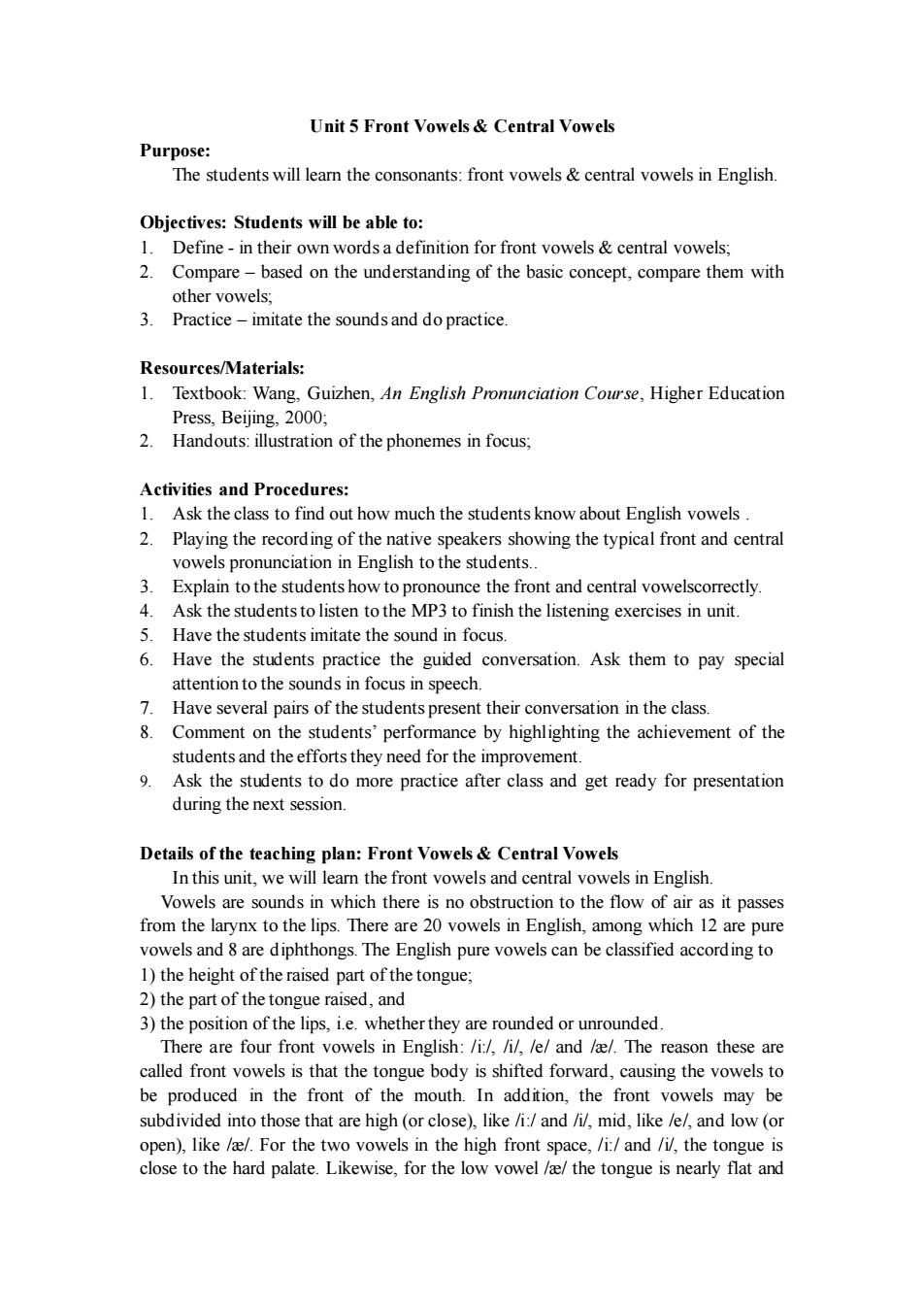正在加载图片...

Unit 5 Front Vowels Central Vowels Purpose: The students will leam the consonants:front vowels central vowels in English. Objectives:Students will be able to: 1.Define-in their own words a definition for front vowels central vowels: 2.Compare based on the understanding of the basic concept,compare them with other vowels, 3.Practice-imitate the soundsand do practice. Resources/Materials: 1.Textbook:Wang.Guizhen,An Engish Co Higher Education Press,Beijing.2000 2.Handouts:illustration of the phonemes in focus; Activities and Procedures: 1.Ask the class to find out how much the students know about English vowels 2. Playing the rec rding of the native speakers showing the typical front and central vowels pronunciation in English to the students. 3.Explain to the students how to pronounce the front and central vowelscorrectly. 4.Ask the students to listen to the MP3 to finish the listening exercises in unit. 5.Have the students imitate the sound in focus. 6. Have the students s practice the conversation.Ask them to pay special attention to the sounds in focus in speech. 7.Have several pairs of the students present their conversation in the class. 8.Comment on the students'performance by highlighting the achievement of the students and the efforts they need for the improvement. 9 Ask the students to do more practice after class and get ready for presentation during the next session Details of the teaching plan:Front Vowels Central Vowels In this unit,we will learn the front vowels and central vowels in English. Vowels are sounds in which there is no obstruction to the flow of air as it passes from the la x to the lips e20 owels in English, amo which 12 re pu upioa passe so aind s suo 1)the height of the raised part of the tongue; 2)the part of the tongue raised,and 3)the position of the lips,ie.whether they are rounded or unrounded. Ther are four front wels in English:e and /ae/.The reason these are caled is that the ton body shi ard,causing the vowels t be produced in the front of the mouth.In addition,the front vowels may be subdivided into those that are high (or close),like /i:/and /i/,mid,like /el,and low (or open).like /ae/.For the two vowels in the high front space,/i:/and /il,the tongue is close to the hard palate.Likewise,for the low vowel //the tongue is nearly flat andUnit 5 Front Vowels & Central Vowels Purpose: The students will learn the consonants: front vowels & central vowels in English. Objectives: Students will be able to: 1. Define - in their own words a definition for front vowels & central vowels; 2. Compare – based on the understanding of the basic concept, compare them with other vowels; 3. Practice – imitate the sounds and do practice. Resources/Materials: 1. Textbook: Wang, Guizhen, An English Pronunciation Course, Higher Education Press, Beijing, 2000; 2. Handouts: illustration of the phonemes in focus; Activities and Procedures: 1. Ask the class to find out how much the students know about English vowels . 2. Playing the recording of the native speakers showing the typical front and central vowels pronunciation in English to the students. 3. Explain to the students how to pronounce the front and central vowelscorrectly. 4. Ask the students to listen to the MP3 to finish the listening exercises in unit. 5. Have the students imitate the sound in focus. 6. Have the students practice the guided conversation. Ask them to pay special attention to the sounds in focus in speech. 7. Have several pairs of the students present their conversation in the class. 8. Comment on the students’ performance by highlighting the achievement of the students and the efforts they need for the improvement. 9. Ask the students to do more practice after class and get ready for presentation during the next session. Details of the teaching plan: Front Vowels & Central Vowels In this unit, we will learn the front vowels and central vowels in English. Vowels are sounds in which there is no obstruction to the flow of air as it passes from the larynx to the lips. There are 20 vowels in English, among which 12 are pure vowels and 8 are diphthongs. The English pure vowels can be classified according to 1) the height of the raised part of the tongue; 2) the part of the tongue raised, and 3) the position of the lips, i.e. whether they are rounded or unrounded. There are four front vowels in English: /i:/, /i/, /e/ and /æ/. The reason these are called front vowels is that the tongue body is shifted forward, causing the vowels to be produced in the front of the mouth. In addition, the front vowels may be subdivided into those that are high (or close), like /i:/ and /i/, mid, like /e/, and low (or open), like /æ/. For the two vowels in the high front space, /i:/ and /i/, the tongue is close to the hard palate. Likewise, for the low vowel /æ/ the tongue is nearly flat and